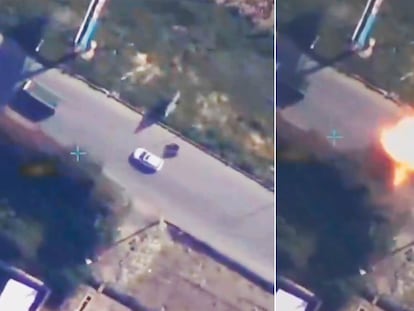Manuel Ricardo, terrorism expert: ‘After a traumatic event like the attacks in Lebanon, people distrust any connected device’
The professor, who specializes in criminal groups, says that the mass detonation of pagers and walkie-talkies creates ‘a psychosis of absolute insecurity’

The attacks in Lebanon — which used explosives installed in pagers and walkie-talkies — have not only resulted in direct casualties. By using electronic devices as a weapon, the attacks have also sparked widespread insecurity, as any device is seen as a potential threat. Manuel Ricardo Torres — a professor of Political Science at the Pablo de Olavide University in Spain who has worked with the European Counter-Terrorism Centre (Europol) — knows this well. He talked to EL PAÍS about the consequences of the latest attacks in the Middle East.
Question. How do you define attacks via personal devices?
Answer. The devices, as far as we know, have been physically manipulated. We are talking about a classic intelligence operation: infiltrating a logistics network to manipulate a series of hardware devices covertly without the recipient being aware. As for remote activation, we do not know much at this time.
Q. What are the effects, other than bodily injury?
A. One of the effects of this action is to foster a psychosis of absolute insecurity about anything around us, because it can be used by the enemy. As for Hezbollah [the pro-Iranian group in Lebanon, the main target of the attacks], it is currently in a moment of extreme weakness because a large number of members of the organization have been effectively put out of action. Even those who have the capacity to continue operating are in panic. They will try not to communicate with each other or take any kind of risk because they are not sure how far the infiltration goes. It will be difficult for a group that has been depleted overnight to defend their infrastructure. Tactically, it is very important because it achieves two things: physical harm to people and cutting off organization, which will now have many problems coordinating, organizing a retaliation or even defending itself against a clear attack by Israel.
Q. Is it that important?
A. When you suffer such a traumatic event, you tend to distrust anything that is connected and that is not a face-to-face interaction. For a group like Hezbollah, that is very problematic. It is one of the paradoxes that are studied in the field of terrorism: for an armed organization, growing and mobilizing a number of people that allows it to carry out more ambitious operations is an advantage; but at the same time, it forces that organization to begin to bureaucratize the processes and, inevitably, resort to modern communications. Managing an organization that mobilizes thousands of people means you have to stop using procedures typical of small groups that operate clandestinely. Telephone or computer communications can be a vulnerability, but without them, you cannot instantly mobilize an entire organization and coordinate it toward a single purpose. Setting up a group of isolated cells where information is not fluid and where no one has an overall vision is not very effective. This is one of the successes of this operation: it has shown that the current structure does not have much of a future.
Q. What if the tactic of introducing explosives into devices is carried out in areas outside the conflict?
A. This has happened. It is not that new, either. Israel used it before in individual operations, such as the killing of Yahya Ayyash in Gaza in January 1996. [Nicknamed “The Engineer” because he was considered Hamas’ main bomb maker, Ayyash was killed with a manipulated cell phone that was detonated remotely.] But doing this kind of thing is very complex and difficult to execute successfully: you have to manipulate the device and get it to the recipient without raising suspicion. It is something that until now was reserved for high-value targets. What is new now is that it has been implemented on a massive scale, but that may have been just to exploit an opportunity. Terrorist groups have used this type of procedure. Al-Qaeda, for example, also hid explosives in printers that it tried to send via commercial transport, but they were intercepted.
Q. Should we be worried?
A. Everyone is looking closely at what has happened. Not just the states themselves, but also terrorist and insurgent groups. But there is no need to be worried. The psychosis about all devices is unfounded. What has happened is not the manipulation of a general-use device, which turned into a deadly weapon. It was the physical manipulation to introduce explosive into devices for exclusive use. It is not that someone, from a distance, activated malware to make the phone explode.
Q. Can it be considered part of hybrid warfare?
A. When we talk about hybrid warfare, we include actions that are outside the scope of violence to weaken the enemy. Here physical violence has been used, and I continue to see it as a traditional intelligence operation, although it has been spectacular in terms of its effects and scope. But it is not an unprecedented novelty either.
Q. Do these acts succeed in frightening the general population?
A. The psychological effect is tremendous. In these attacks, unlike others in the past, there is much more correspondence between the damage caused and the fear generated. When the leader of an organization was attacked, this was not seen. In the recent attacks, the victims were everyone who had a device, and it is logical that everyone can feel potentially targeted and not just those most exposed, such as the leaders of the organization. Now any member of the rank and file or someone who performs auxiliary functions can be a victim.
Q. Do the attacks force us to review security protocols in the supply chains of any device?
A. This fear already existed and is behind the policy of vetoing certain Chinese companies from supplying critical infrastructure. It is due to this fear of importing a technology that we are not sure has been manipulated at some point. The attacks, on the one hand, reinforce the attitude of not buying anything from someone without the absolute certainty that they cannot use it against you. It is also a lesson for Hezbollah for purchasing devices from the same firm on a massive scale.
Q. Can current security methods, such as airport scanners, detect the presence of explosives in a cell phone?
A. These systems are effective if they know what they are looking for because they adapt to the indicators of what is being looked for, what the threat is and how it manifests itself. But a type of explosive can be developed with characteristics that go unnoticed. In airports, we have to take off our shoes because of an attempted attack in 2002 with a powerful explosive hidden in a wide sole.
Q. Are there any more reports of explosives in unexpected places?
A. In 2006, a liquid explosive was detected and since then, the quantities that can be brought into the airport have been limited because there are not enough resources to identify each of the liquids contained in the containers that people carry with them.
Q. What measures can be taken now?
A. If the possible form that the threat will take is identified, countermeasures can be taken. But in the abstract, it is practically impossible. It is a dynamic process: terrorist groups have to innovate because the procedures they used in the past are no longer useful for countermeasures. We are forced to be equally dynamic. Measures cannot be taken when it is too late, but rather when an alarm signal or a probability is identified. It is like a game of cat and mouse. Whoever falls asleep loses. The race to find new ways and neutralize them is constant.
Sign up for our weekly newsletter to get more English-language news coverage from EL PAÍS USA Edition
Tu suscripción se está usando en otro dispositivo
¿Quieres añadir otro usuario a tu suscripción?
Si continúas leyendo en este dispositivo, no se podrá leer en el otro.
FlechaTu suscripción se está usando en otro dispositivo y solo puedes acceder a EL PAÍS desde un dispositivo a la vez.
Si quieres compartir tu cuenta, cambia tu suscripción a la modalidad Premium, así podrás añadir otro usuario. Cada uno accederá con su propia cuenta de email, lo que os permitirá personalizar vuestra experiencia en EL PAÍS.
¿Tienes una suscripción de empresa? Accede aquí para contratar más cuentas.
En el caso de no saber quién está usando tu cuenta, te recomendamos cambiar tu contraseña aquí.
Si decides continuar compartiendo tu cuenta, este mensaje se mostrará en tu dispositivo y en el de la otra persona que está usando tu cuenta de forma indefinida, afectando a tu experiencia de lectura. Puedes consultar aquí los términos y condiciones de la suscripción digital.
More information
Archived In
Últimas noticias
All the effects of gentrification in one corner of Mexico’s Colonia Roma
Palestinian reporter Youmna El Sayed: ‘My family told me I had to choose between being a journalist or a mother’
Christmas loses its festive spirit: ICE fears cast shadow over religious celebrations
The new language of the workplace: Knowing how to ask AI questions is more important than using it
Most viewed
- The low-cost creative revolution: How technology is making art accessible to everyone
- Families demand repatriation of bodies of Colombians who died in Ukraine: ‘This war is a slaughterhouse for foreigners’
- Christian Louboutin: ‘Young people don’t want to be like their parents. And if their parents wear sneakers, they’re going to look for something else’
- US sanctions against jailed cartel leader ‘El Marro’ highlight Mexico’s lack of control over its prisons
- Liset Menéndez de la Prida, neuroscientist: ‘It’s not normal to constantly seek pleasure; it’s important to be bored, to be calm’











































